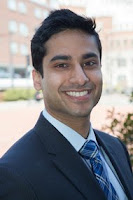One of my other lesser known blogs is "The View from Here". My topics there are in a slightly different realm. I was reviewing it last night and came across several germane topics for Health Train Express.
When the Doctor Doesn’t Look Like You (or me)
So, your doctor doesn't look like you ? Don't sweat it !
For more than 50 years, international medical school
graduates have filled the gaps in the physician work force
in the United States. Currently, they make up fully
one-quarter of all practicing physicians, and
although a majority
are foreign-born, approximately 20 percent are
American citizens who have chosen to go abroad, most
notably to the Caribbean, for medical school.
Regardless of whether they are United States citizens,
all international graduates must go through an arduous
regulatory process before practicing in this country, a
process that includes verification of medical school
diplomas and transcripts, residency training in
American hospitals and the same national three-
part licensing exams and specialty tests that their
medical school counterparts in this country take.
Many go on to choose specialties or work in the rural
and disadvantaged geographic locations that their
American counterparts shun. International graduates,
for example, now account for nearly 30 percent of all
primary care doctors, a specialty that has had increasing
difficulties attracting American medical
students...........................
Now researchers from the Foundation for Advancement of
International Medical Education and Research in
Philadelphia have published the first study incorporating
new research methods for evaluating the performance
of large groups of physicians. And it turns out that contrary
to certain individuals’ worst fears, accent or nationality
did not affect patient outcomes. Rather, the main factor
was being board-certified: completing a full residency at an
accredited training program, passing written and, depending
on the specialty, oral examinations, and having proof of
experience with a defined set of clinical problems and technical
procedures.
Foreign medical graduates also tend to 'cluster' choosing to practice in like minded communities, Asian, Phillipino, Latino, Jewish, and other minorities. These demographics also tend to refer internally when possible.
Racial prejudice exists even in health care.
Teaching Doctors the Art of Negotiation - The New York Times
Doctors negotiate every day, almost constantly — sometimes dramatically, often imperceptibly. They hold family meetings to resolve sensitive end-of-life issues. They address barriers to medication adherence. They encourage patients to receive uncomfortable screenings like colonoscopies and mammograms. They refuse treatments that are requested but not medically indicated. Yet they receive almost no formal instruction in how to do so.
Dealing with medical colleagues creates an additional layer of negotiating complexity—especially in busy academic centers with competing demands on specialists’ time. Medicine is increasingly a team sport. In 1970, only about 2.5 full-time clinical staff cared for the average hospital patient; today, that number is greater than 15.
Doctors consult other doctors many times a day to discuss potential treatment options and decide on the best course of action. They work closely with residents, students, nurses, physician assistants, care coordinators and others to implement those plans. At each interaction, opportunities for collegiality and efficiency — or rancor and resentment — abound. That can mean the difference between a timely or delayed blood draw, accepting or refusing a consult, or getting those biopsy results today versus tomorrow.
Recognizing the importance of negotiation, medical schools are starting to invest in communication training for students — and it seems to be paying off. Research suggests communication training can improve patient adherence, diagnostic accuracy and chronic disease management. But good communication, by itself, is only part of the solution. We need to teach doctors how to negotiate.
Negotiation, in this context, is not about winning or losing, or haggling over price or scare resources. It’s about exploring underlying interests and positions to bring parties together in a constructive way. It’s about creative, innovative thinking to create lasting value and forge strong professional relationships. It’s about investigating what is behind positions that may seem irrational at first to understand the problem behind the problem.
The medical profession is no longer one in which doctors dictate a given treatment course to patients, who are then expected to follow it. Rather, clinicians and patients deliberate about treatment options, weigh costs and benefits together, and determine the best course of action. This approach requires eliciting patient concerns and addressing underlying fears to arrive at the most effective strategy for maximizing health and well-being. As diseases like H.I.V. and some cancers that were once uniformly fatal become chronic conditions, and a greater diversity of treatment options becomes available, the ability to negotiate long-term care plans will only grow in importance.
Healthcare Stole the American Dream - Here’s How We Get it Back | Dave C..., Bay Area Cancer Patient..
|



No comments:
Post a Comment